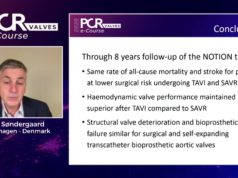
One-year findings from the EXPAND registry, evaluating real-world use of newer-generation MitraClip (Abbott) devices for the treatment of secondary mitral regurgitation, are comparable to the results witnessed in the COAPT randomised study of an earlier generation of the device.
This was among the messages presented by Jörg Hausleiter (Klinikum der Universität München, Munich, Germany) who presented the contemporary, real-world clinical outcomes with the next generation MitraClip (NTR/XTR) system, in patients with secondary mitral regurgitation in a later-breaking trial session at the PCR Valves e-course (22-24 November, virtual).
The COAPT study has demonstrated the significant clinical benefit of the Mitraclip in patients with secondary MR, but the COAPT patient population was highly selected and only the first generation of MitraClips was used, Hausleiter said in the introduction to his presentation.
Thus, the EXPAND registry was started to study the outcomes of MitraClip procedures in a real-world setting and also to evaluate the use of the third generation of MitraClip with the smaller NTR and the larger XTR clip systems
The EXPAND study included a total of 1,041 patients from the USA and Europe, with Hausleiter’s presentation focusing on the one-year outcomes of 413 patients treated with a MitraClip for secondary MR, and with availability of echo analysis.
Hausleiter compared the characteristics of the EXPAND population to that of the COAPT trial, noting that left ventricular end diastolic volume index was comparable between the two studies, but pointing out that the mean effective regurgitant orifice area (EORA) was smaller in EXPAND than in COAPT, and the incidence of left ventricular ejection fraction (LVEF) was higher in EXPAND.
Outlining the results, Hausleiter commented that the one-year mortality rate seen in EXPAND, of 70.7% compared well to the observed rate of 90.1% in COAPT. The rate of heart failure hospitalisations was 26%, “which also compares well with the data from COAPT of 24.9%”, said Hausleiter. Furthermore, he added, the rates for myocardial infarction, stroke and repeat interventions were similar.
Hausleiter commented that the study, which is the first contemporary report of outcomes in patients with secondary MR treated with the MitraClip NTR and XTR systems, showed that a durable MR reduction was achieved in the EXPAND population, which appeared numerically higher than in COAPT.
The study elicited comparable rates all-cause mortality and heart failure hospitalisation at one-year compared to COAPT, as well as a higher improvement in Quality of Life (QoL) and similar symptomatic improvement, irrespective of the baseline orifice area or clip type.
In summary, Hausleiter said that the EXPAND study confirms that mitral valve repair, in a real-world contemporary setting, with two Mitraclip sizes is associated with favourable one-year outcomes, that are comparable to the randomised COAPT results.













